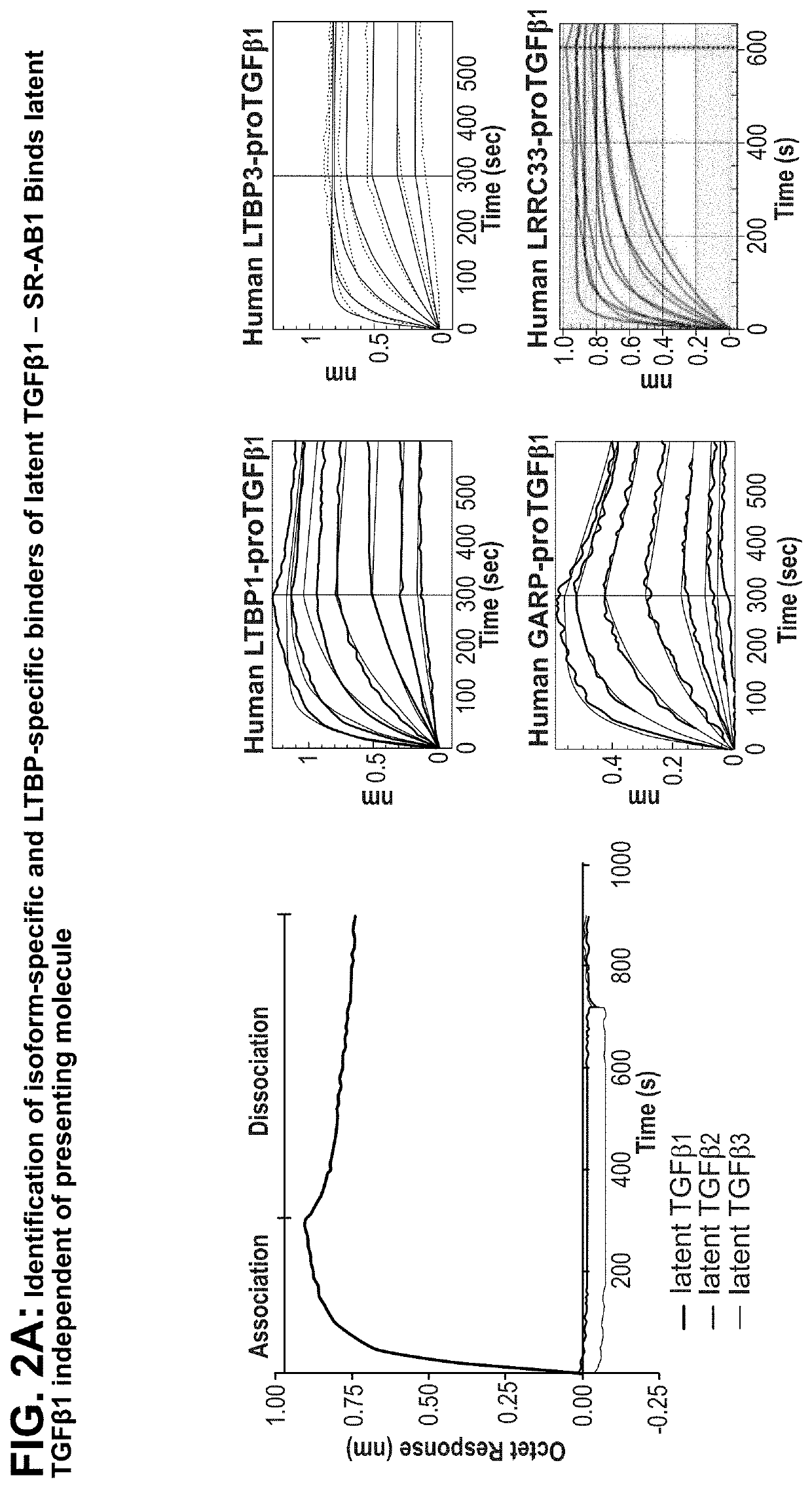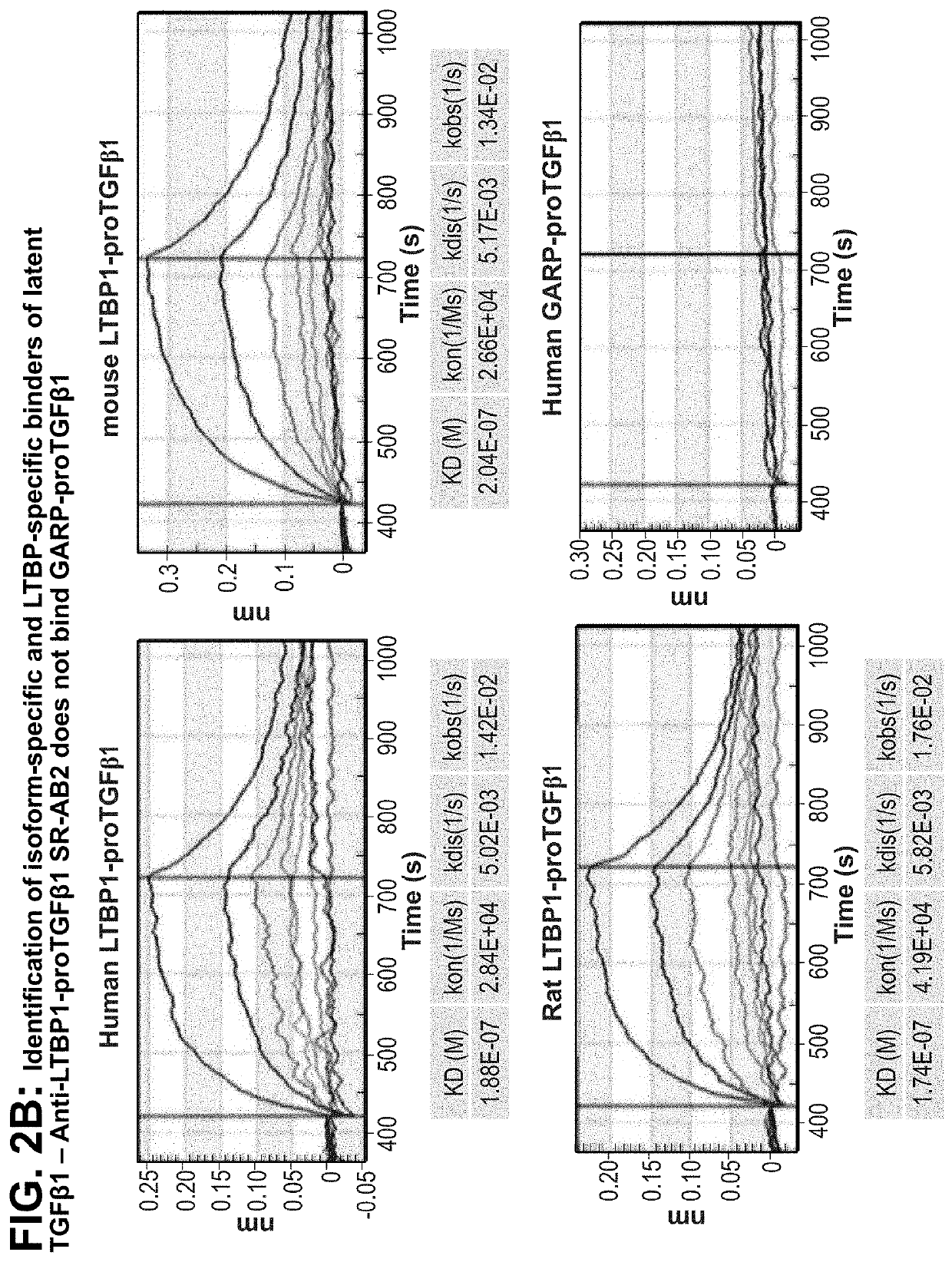Ltbp complex-specific inhibitors of tgf-beta 1 and uses thereof
a technology of ltbp and complex, which is applied in the field of complex-specific inhibitors of tgfbeta 1 and its use, can solve the problems of difficult clinical development of tgf therapeutics, often losing their negative growth response to tgf, and most clinical programs targeting tgf have been discontinued. , to achieve the effect of modulating the release of mature tgf1 growth factor
- Summary
- Abstract
- Description
- Claims
- Application Information
AI Technical Summary
Benefits of technology
Problems solved by technology
Method used
Image
Examples
example 1
nt of Context-Specific Inhibitors that Bind a LTBP1 / 3-TGBβ1 Complex
[0326]A control antibody, SR-AB1, was used as a control. SR-AB1 binds latent TGBβ1 independent of the presenting molecule (see FIG. 2A).
[0327]Antibodies that are selective for TGFβ1-containing large latent complexes were developed. SR-AB2 was selected for further analysis using the functional assays described in the below examples. The heavy and light chain variable regions of SR-AB2 were sequenced (FIG. 8); complementarity determining regions are underlined. It was demonstrated that SR-AB2 binds LTBP-presented latent TGFβ1 complexes but does not bind GARP-TGFβ1 or proTGFβ1 alone (FIG. 2B). However, as described below, the functional effect of such selective binding was unknown and could not be determined using currently known techniques without the further development of novel functional assays.
example 2
l Assays to Detect Inhibition of Activated Recombinant Latent TGFβ1
[0328]In order to identify isoform-specific inhibitors that bind the latent TGFβ1 prodomain, with no detectable binding to latent TGFβ2 or TGFβ3, and that inhibit integrin-mediated activation of latent TGFβ1 in vitro with context-dependency, new functional assays were required. Prior to the instant invention, assays were not available which could detect isoform-specific TGFβ1 antibodies that bound only to LTBPs. Specifically, previous assay formats could not differentiate between the activation of proTGFβ1 presented by endogenous presenting molecules and the activation of proTGFβ1 presented by exogenous LTBPs. By directly transfecting integrin-expressing cells, the novel assays disclosed herein establish a window between endogenous presenter-proTGFβ1 activity and exogenous LTBP-proTGFβ1 activity. As LTBP-proTGFβ1 complexes are embedded in the extracellular matrix, the assay plate coating is also an important componen...
example 3
a Complex-Specific Inhibitor of LTBP-proTGFβ1
[0429]SR-AB2 was selected for further analysis. It was demonstrated that SR-AB2 specifically binds to proTGFβ1:LTBP1 & 3 complexes (FIG. 9).
[0430]As discussed above, LTBP1 and LTBP3 are deposited in the extracellular matrix, while GARP / LRRC32 and LRRC33 present latent TGFβ1 on the surface of immune cells. It was demonstrated that SR-AB2 inhibits LTBP-proTGFβ1 signaling, but does not affect GARP-proTGFβ1 (FIG. 10A and FIG. 10B). FIG. 10A demonstrates that SR-AB2 inhibits LTBP-proTGFβ. This assay was performed in LN229 cells, which express high LTBP1 & 3, undetectable GARP and LRRC33. FIG. 10B demonstrates that SR-AB2 does not inhibit GARP-proTGFβ. SR-AB1 binds latent TGBβ1 independent of the presenting molecule. proTGFβ1 is presented by overexpressed GARP. This assay was performed in LN229 cells, which express high levels of LTBP1 & 3, and undetectable levels of GARP and LRRC33.
[0431]Inhibition of LTBP-proTGFβ1 by SR-AB2 was also shown in ...
PUM
| Property | Measurement | Unit |
|---|---|---|
| dissociation constant | aaaaa | aaaaa |
| temperature | aaaaa | aaaaa |
| dissociation constant | aaaaa | aaaaa |
Abstract
Description
Claims
Application Information
 Login to View More
Login to View More - R&D
- Intellectual Property
- Life Sciences
- Materials
- Tech Scout
- Unparalleled Data Quality
- Higher Quality Content
- 60% Fewer Hallucinations
Browse by: Latest US Patents, China's latest patents, Technical Efficacy Thesaurus, Application Domain, Technology Topic, Popular Technical Reports.
© 2025 PatSnap. All rights reserved.Legal|Privacy policy|Modern Slavery Act Transparency Statement|Sitemap|About US| Contact US: help@patsnap.com



